What is Murphy’s Law?
Smartpedia: Murphy’s Law states that if anything can go wrong, it will. It is based on an observation by Edward A. Murphy Jr. but is not a law of nature.
Murphy’s Law – Everything that can go wrong, does!
Edward Aloysius Murphy Jr. was an American engineer for the United States Air Force. In the course of a test arrangement to find out what acceleration forces a human body can endure, Murphy made the statement1 as a result of a faulty assembly of sensors1:
“If there’s more than one possible outcome of a job or task, and one of those outcomes will result in disaster or an undesirable consequence, then somebody will do it that way.”
Abbreviated and generalised, this statement became Murphy’s Law: “Anything that can go wrong will go wrong”.
Murphy’s Law is of course not a law of nature. Just because anything can go wrong doesn’t mean it really will. If a project or experiment fails, Murphy’s Law provides neither correlation nor causality.2 Positively formulated, the law is based on empirical values; negatively formulated, it is based on cognitive distortion and the erroneous and unconscious tendency of people to perceive, remember, think and judge. Thus, negative events often carry more weight than positive ones.
The appeal in Murphy’s law
There is an appeal in Murphy’s Law: if anything can go wrong, it will – so people, teams, organisations should examine all the ways it can go wrong and take appropriate precautions or countermeasures. It’s an appeal,
- to think in complex terms,
- to allow for human error,
- identify and minimise sources of error.
- to consider, analyse and evaluate risks in order to determine measures to avoid, minimise or tolerate them.
Often, not all contingencies can be identified in advance of an experiment or decision. Here, there is an approach with Effectuation, which has a different background but names principles for situations of uncertainty and insecurity.
Similar laws and variations of Murphy’s Law
There are a number of similar “laws” such as
Finagle’s Law of Dynamic Negatives – in short Finagle’s Law3: “Everything that can go wrong will go wrong – and at an inopportune moment”. In a way, Chaos Engineering follows this thought.
Yhprum’s Law (Yhprum is an ananym of Murphy) is the inverse of Murphy’s Law: “Anything that can work will work”. Sometimes this law can be observed in practice when systems that should not work surprisingly do.
Sod’s Law says: “If something can go wrong, it will”. Compared to Murphy’s Law, Sod’s Law is considered a more extreme version. While Murphy’s Law states that anything that can go wrong will (eventually) go wrong, Sod’s Law states that things must always go wrong, with the worst possible outcome.4
On the internet you can find numerous – sometimes very funny – formulations that complement Murphy’s Law. Here is a small selection:
- Nothing is as easy as it looks.
- Everything takes longer than you think.
- If there is a possibility that several things will go wrong, the one that causes the most damage will go wrong.
- If there is a worse point at which something can go wrong, it will.
- If something just can’t go wrong, it will still happen.
- If you recognise that there are four ways a procedure can go wrong and work around them, then a fifth possibility will promptly arise that you are not prepared for.
- If you leave things to themselves, they tend to get worse and worse.
- If everything seems to be going well, you have obviously overlooked something.
- Nature always sides with the hidden fault.
- It is impossible to make anything foolproof because fools are so inventive.
- Whenever one sets out to do something, something else has to be done first.
- Every solution entails new problems.
- If something cannot go wrong by itself, someone will make it go wrong.
Surely this list can easily be extended. It becomes really interesting when you consider what such formulations could mean for your plans and what conclusions you would draw from them in individual cases. However, it may be enough to know them and perceive them as cognitive distortions.
Impulse to discuss
How can organisations avoid cognitive biases in everyday work?
Notes:
[1] Depending on the source, the origin of the statement varies. It was probably made in the detailed version in 1949 by Colonel John Paul Stapp at a press conference, who attributed it to Edward A. Murphy. One source even says that Murphy was so annoyed with the engineer who had mounted the sensors incorrectly that he got carried away with “If that guy has any way of making a mistake, he will”. Only in the course of the press conference did this become the seemingly universal “Anything that can go wrong, will go wrong!”. The fastest man on earth is a relevant source.
[2] If a jam sandwich falls from the kitchen table onto the floor, it relatively regularly lands on the side with the jam spread. This is often cited as an example of Murphy’s Law, but in fact it often falls on the side with the jam spread, because the height of the table or the height of the fall does not allow for a full rotation of the bread.
[3] The English verb to finagle means “to cheat” or “to fudge”; in relation to experiments, it can be inferred that regardless of the result, there is always someone who misinterprets, fudges or believes that result to be in accordance with their pet theory. See: Finagle’s Law.
[4] The existence of Sod’s Law is considered by some publicists as (ironic) evidence that Edward A. Murphy was in fact an optimist.
If you like the article or would like to discuss it, please feel free to share it in your network. And if you have any comments, please do not hesitate to send us a message.
And here you will find additional information from our t2informatik Blog:



